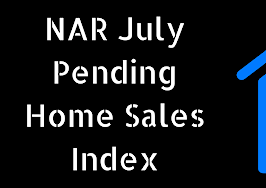- Here's a recap of pending home sales, existing home sales, price indices and studies from NAR, S&P Dow Jones, Zillow and Trulia.
Every month, economists release a number of indices, reports and analyses of the housing market, and it can be difficult to keep up with them all.
Thankfully, the National Association of Realtors (NAR) recapped the month in its new Housing Minute monthly video series.
July sales dipped 1.3 percent to a SAAR of 5.44 million — down from a downwardly revised 5.51 million in June, and home sales prices rose 6.2 percentage points to $258,300.
- NAR Chief Economist Lawrence Yun said the dip in existing-home sales prices isn’t due to a lack of buyer desire or demand. Instead, it’s due to continuing issues with low inventory made worse by sluggish residential housing starts.
- “Home prices are still rising above incomes, and way too fast in many markets,” Yun said. “Realtors continue to say prospective buyers are frustrated by how quickly prices are rising for the minimal selection of homes that fit buyers’ budget and wish list.”
- The S&P Case-Shiller Home Price Indices reported the seventh consecutive month of new home price peaks.
- S&P Dow Jones Indices managing director and chairman of the index committee David M. Blitzer, like Yun, blames low housing starts for booming home prices.
- “Currently the months-supply of existing homes for sale is low, at 4.2 months,” Blitzer said. “In addition, housing starts remain below their pre-financial crisis peak as new home sales have not recovered as fast as existing-home sales.
July pending home sales took a hit as well. Contract signings declined 0.8 month-over-month and 1.3 percent year-over-year to 109.1.
- Each region, except the West, experienced declines in contract signings in July.
- Much like his assessment of July’s existing-home sales, Yun said a lack of inventory has the housing market in a “holding pattern.”
- “The housing market remains stuck in a holding pattern with little signs of breaking through. The pace of new listings is not catching up with what’s being sold at an astonishingly fast pace,” he noted.
On a more positive note, a recent Zillow study revealed nearly half of U.S. homes are now more valuable post-recession.
- Zillow analyzed the Zestimates of homes pre- and post-recession in the 50 largest metros and found that 48.9 percent of homes nationwide are worth more post-recession.
- In Denver, Colorado; Dallas, Texas; Nashville, Tennessee; Portland, Oregon; Raleigh, North Carolina; Louisville, Kentucky; and San Jose, California; more than 90 percent of homes are now worth more than they were in 2007.
- In Denver, 99.5 percent of homes have exceeded their pre-recession values. Denver’s latest Zillow Home Value Index (ZHVI) is at $371,100 — 57.3 percent above its April 2006 peak of $235,900.
- On the other hand, Las Vegas, Nevada, has fared the worst. A minuscule 0.4 percent of homes exceeding their pre-recession Zestimate peak value.
Lastly, Home Innovation Research Labs found an interesting way to study the health of the housing market. HIRL researchers turned to building material demand to reveal what’s really going on with the housing market.
- According to HIRL’s 2017 Builder Practices Survey, buyers are giving the cold shoulder to once popular luxury materials and finishes in favor of more affordable options.
- In 2015, jetted tubs were installed in 15 percent of all new builds. That share dropped 4 percentage points to 11 percent in 2016. Meanwhile, cost-effective engineered hardwood and ceramic tile experienced a 3 percentage point jump in the market share.
- HIRL said the move toward mid-range materials lines up with the “overall move to the middle” when it comes to buying homes.
- The market share of luxury homes ($500,000 and above) and multifamily housing ($150,000 and below) has dropped while single-family detached and move-up homes, which hover around the $260,000 mark, experienced the greatest increases.
- This is due, in part, to the fact that luxury homes are out of reach for most, and the most affordable homes are being snapped up at record speed, leaving mid-range (also known as move-up) homes as the most plentiful option.



